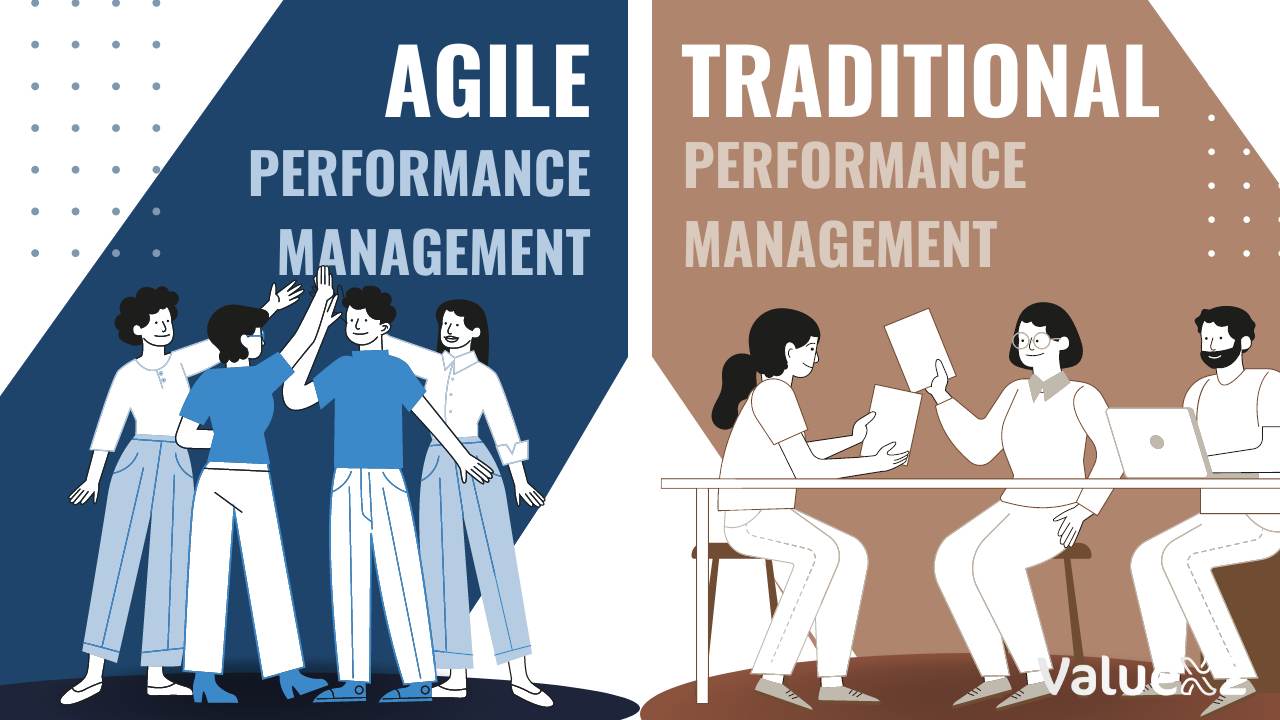Reading Time: 5 minutesKnow the 5 key advantages of Agile Performance Management over traditional methods to improve employee engagement, productivity, and overall organizational growth.

Evolution has been there since the beginning of time. As time has gone by, we have learned, witnessed and even experienced change and development. In the business world as well, evolution has occurred and businesses are no longer trying to use the traditional approaches. Instead, they are embracing new methods. Currently, agile tools and methodologies are the ones that have brought a positive change in the organizational culture. If you’ve been wondering how these agile methods actually reshape HR at its core, the Agile HR Operating Model can be a really useful resource for you. We will guide you through the important building blocks, from redefined roles to flexible governance and beyond, to enable you to begin the process of evolving how you think about HR, not like your typical support function, but towards a true agile, people-first change maker.
The traditional performance management is viewed as outdated and ineffective in today’s dynamic workplace. However, Agile Performance Management has emerged as a more flexible and adaptable approach that aligns with the fast-paced nature of modern businesses. This article will delve into the five primary advantages of Agile Performance Management compared to traditional methods, showing how this innovative approach can improve employee engagement, productivity, and overall organizational outcomes.
What is Agile Performance Management?
Agile performance management is a novel approach to measuring and developing performance. It dispenses with old-fashioned performance appraisal and embraces flexibility instead. Agile performance management is a progressive system that differs from the conventional performance management system that depends on once-a-year performance appraisal and analyzed metrics.
Key Elements of Agile Performance Management
- Continuous Feedback: Open and continuous dialogue between managers and subordinates creates work improvements during the discussion.
- Adaptability: It is usual to have a check on goals and priorities set since business needs may change over time.
- Collaboration: Promotes collaboration and cooperative resolution of issues to improve results.
- Employee Empowerment: Helps manage individual transformation via individual coaching and counselling.
Benefits of Agile Performance Management
Here are 5 the advantages of agile performance management over traditional performance management:
1. Continuous Feedback and Coaching Culture
One of the advantages of Agile Performance Management is that it promotes a culture of ongoing feedback and coaching. Managers and employees engage in regular conversations. This aids in guidance, support and recognition. This continuous feedback loop enhances communication, improves performance, and allows for quick adjustments and improvements. If you’re kinda stuck on how to actually roll out a proper feedback flow—like weekly check-ins, those quick retros, or just that “in-the-moment” coaching stuff, don’t worry. We’ve got a full breakdown in our guide on Implementing Agile HR Practices to Transform HR Operations. It’s messy at first, but this’ll help you get it going, step by step.
2. Agile Goal Setting and Adaptability
Traditional performance management relies on annual or long-term goal setting, which can become irrelevant or outdated. Agile Performance Management, however, embraces shorter-term goals and allows for flexibility and adaptability. Agile teams collaboratively set goals and continuously evaluate and adjust them based on evolving priorities and market conditions. This agile approach ensures that employees remain focused on relevant objectives and can swiftly respond to changing business needs.
3. Empowered and Autonomous Teams
Another one of the crucial advantages of Agile Performance Management is that it gives employees more control and responsibility for their work. Instead of being closely supervised, individuals are encouraged to take charge, make choices, and try new methods. This greater freedom instils a sense of empowerment, motivation, and creativity in employees, resulting in increased engagement and productivity levels.
4. Team Collaboration and Cross-Functional Alignment
Traditional performance management focuses primarily on individual performance, inadvertently neglecting the significance of teamwork and collaboration. In contrast, Agile Performance Management places a strong emphasis on fostering collaboration and cross-functional alignment. Agile teams work together to achieve common goals, leveraging their diverse skills and perspectives. This collaborative approach not only enhances individual performance but also drives innovation, problem-solving, and collective success.
5. Data-Driven Insights and Continuous Improvement
Performance management software and digital platforms enable organizations to collect and analyze data, offering valuable metrics and performance indicators. These data-driven insights enable managers to make informed decisions, identify strengths and areas for improvement, and proactively address any performance issues. For a broader market perspective on the latest data-backed tactics, the AIHR guide to 13 Performance Management Strategies for 2025 is a great point, as it aligns with the latest benchmarks and best practices that complement the agile approach.
Traditional Performance Management vs Agile Performance Management
| Aspects |
Traditional Performance Management |
Agile Performance Management |
| Frequency |
Annual or semi-annual reviews |
Continuous feedback and regular check-ins |
| Focus |
Past performance |
Future growth and adaptability |
| Goals |
Fixed, long-term objectives |
Dynamic, adjustable goals |
| Feedback |
Top-down, formalized |
Collaborative, ongoing |
| Evaluation Criteria |
Standardized metrics and ratings |
Contextual, growth-oriented evaluations |
Become a Certified Agilist
Transform yourself and your organisation with ValueX2’s ICAgile certifications. Catering to working professionals who want to build a career in the new age workplace, ValueX2 provides the best agile training courses for your ideal growth. Our courses, such as Agility in HR, Agility in Marketing, etc will help you realize your goals, like increasing the efficiency of your team or simply outcompeting competitors. Their courses equip you with international certifications in Agile Delivery, Product Ownership, and many others. Explore our curated catalogue of programmes in the Best HR Courses Online – Agility in HR Training section to find the exact details about our Agile in HR program. You’ll know everything we provide from A to Z in this article.
ValueX2 offers qualified trainers and mentors, practical knowledge, and a wide choice of learning paths, so you won’t lag in the Agile Transformation race. Join our agile course today and learn these transformations that create a massive difference right away. Visit ValueX2 to get started!
Conclusion
Agile Performance Management is innovative, encompassing new methodologies and replacing rigid conventional approaches. It encourages feedback, supports fresh activities, organizes coordination, offers flexibility in goal setting and enables personnel to be staffed up, improving the organisational effectiveness. This modern approach supports flexibility, creativity, and concentrating on the profound outcomes for businesses.
The advantages of Agile Performance Management do not end with increased company efficiency and productivity. It leads to employees’ increased engagement, best decision-making, as well as to companies’ ability to maintain their success in today’s world competitive environment.
Frequently Asked Questions (FAQs)
Q. Why is continuous feedback important in Agile Performance Management?
Ans. Regular feedback increases the communication level, results in an immediate enhancement of employee performance, and the necessary corrections may be made as soon as it is needed to meet business goals.
Q. How does Agile Goal Setting benefit employees and organizations?
Ans. Specific, short-term Targets/ Objectives known as Agile Goal Setting can be quickly adjusted to operators’ needs to keep employees engaged in the company.
Q. What role does team collaboration play in Agile Performance Management?
Ans. Teamwork enhances cross-functional coordination, leading to increased problem-solving and innovation hence promoting achievement goals in teams.
Q. How does Agile Performance Management empower employees?
Ans. Agile performance management fosters independence, they empower the workers, allowing them to handle their tasks independently, decide on some aspects and offer solutions consequently increasing their motivation as well as performance levels.
Q. What are the advantages of using data-driven insights in Agile Performance Management?
Ans. Information gathering allows a clear indication of strengths, weaknesses, and improvements required to make effective decision-making possible.
Bhavna is an Agile Coach and Consultant with 15+ years of experience in advisory, corporate finance, IT assurance, and operations at Big 4 and within the industry in the UK and India. She has recently been the CEO of a start-up where she implemented agile practices within HR, Marketing, and Product teams.
She is also a SAFe® Practice Consultant (SPC) and authorized instructor for ICAgile Agility in HR (ICP-AHR), Agility in Marketing (ICP-MKG), and Business Agility Foundations (ICP – BAF) training courses. She provides training for agile transformation to corporate, public, and private batches, as well as consulting for enterprise agile transformation.








